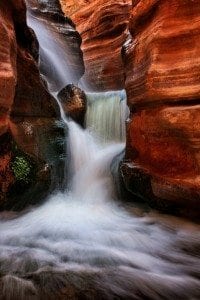5 Bucket List Destinations For The Avid Photographer
From sea to shining sea, the National Park System offers a plethora of remarkable vistas and awe-inspiring experiences. While every location will offer spectacular opportunities for creating gorgeous and memorable prints, there are five national parks that should be on every serious photographer’s bucket list. These parks stand out above all other locations for their unique landforms, intriguing wildlife and exciting natural lighting opportunities.

Grand Canyon NP: Photo by Brandon Jett
Grand Canyon National Park is an obvious choice for budding artists and seasoned photographers. The natural geology of the area allows for provocative and inspiring landscape panoramas. It is very easy to become absorbed in the great expanses the canyon offers though the best views are found in the contrast of hues and elevations. Cape Royal is a favorite of photographers, offering riveting photography opportunities for weather phenomena, especially lightning and cloud movement across the cliffs of the canyon.
Arches National Park in Utah also inspires geological photography. Stunning balanced stones, as well as over 2,000 natural arches created through erosion offer endless opportunities for photographers. Turret Arch is a dynamic scene at sunrise with spectacular contrast and sunset in Arches National Park offers stunning plays of shadow and light.
Badlands National Park offers endless vistas of buttes and gullies, but the true draw for the photographer is the stunning wildlife that roams the park. Pronghorn, bison, white-tailed deer, coyote, ferrets and prairie dogs inhabit the park. Twilight offers a fascinating study in animal behavior, as animals in hiding from the heat of the day emerge from their hiding places to forage and play. Classic Midwestern wildlife paired with expansive prairies and summer wildflowers will capture the spirit of Americana in photographs.
Another exciting opportunity for wildlife photography can be found in Everglades National Park. Foggy marshes and misty labyrinths are home to a variety of large, docile birds that can even be photographed easily by amateurs. Spoonbills, heron, and pelicans are popular draws as they fish the local waters and nest throughout the winter. Woodpeckers and songbirds are more challenging to capture with film; however, their colorful plumage and playful antics easily make it worth the effort. Alligators and ancient large turtles sleepily surface in the murky waters, creating unique wildlife photography opportunities.
Finally, the majestic Grand Teton National Park is an alpine retreat that is unparalleled in mountainous panoramic vistas. Snow-capped peaks dominate views of wildflower groves and lonely stands of willow trees. Hardwood forests cast long shadows over the Snake River. Bison, moose, and elk make chance appearances in lakeside meadows. Long summer days allow the landscape to burst with life in colorful cascading colors. Overall, the pristine wilderness of the Tetons is the perfect backdrop for rugged nature photography.
The National Park system offers access to unblemished lands and an opportunity to capture photographs of endangered wildlife in a natural setting, and while these five parks are beautiful, every park offers its own photographic jewels.
Find out more about these great park destinations and all of America’s more than 400 national parks with the National Park Foundation’s FREE “National Park Owner’s Guide: www.nationalparks.org/ownersguide



